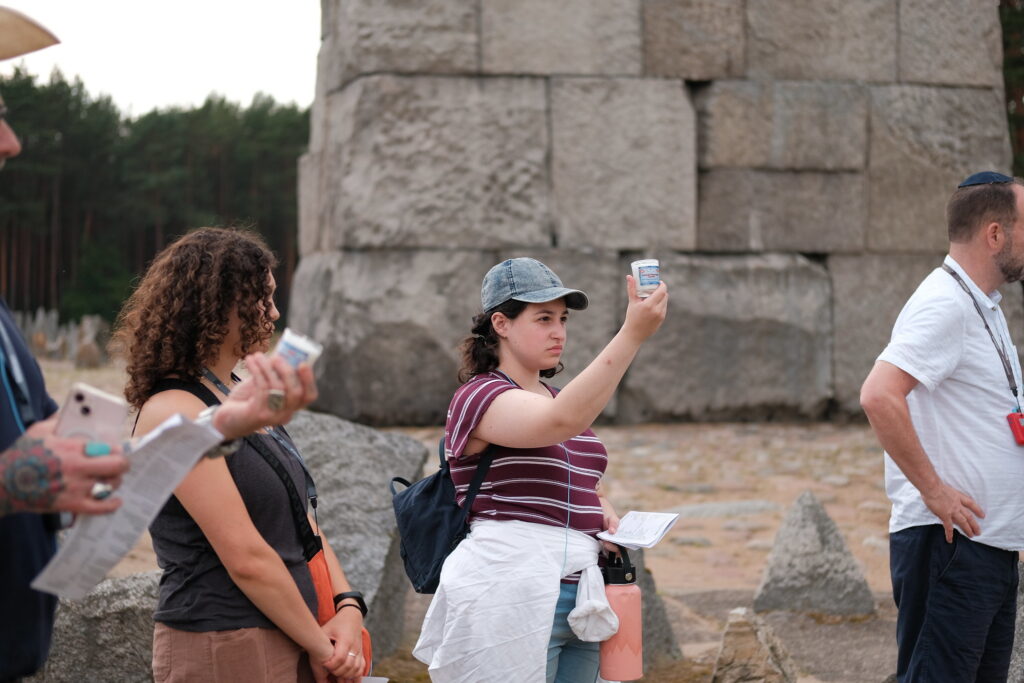At Treblinka, they tried to erase us
Photo: Lev Gringauz – TC Jewfolk
This blog was written on JCRC’s Power of Place educators institute in Europe – an experiential professional development for teachers where learning unfolds as they tour historical sites across Europe in order to transform their understanding of the Holocaust, WWII, antisemitism, and Jewish life today. Power of Place is planned and co-led by Humanus Network on behalf of JCRC and generously supported by the Minnesota Vikings, the Tankenoff Families Foundation, and Allianz of America Corporation.
by Mira Zelle of Minnesota | June 20, 2024
The air was hot and sticky when we got off the bus. It had rained on the drive in, and the sky was still threateningly dark with clouds. We walked single file down the stairs, the previously rowdy group now eerily silent. There was no denying where we were: Treblinka, a death camp about an hour and a half drive north of Warsaw.
That morning, we had toured a majority of the Warsaw ghetto, including the Umschlagplatz where hundreds of thousands of Jews waited to be deported to Treblinka. I found myself imagining their path to get here, vastly different from my journey in a comfortably air conditioned coach bus. Reading the list of villages on the wall, a sampling of the homes of many who were murdered here at Treblinka, my eye caught a familiar name: Zelechow. My family’s last name before it was shortened at Ellis Island, or at least that is how the family legend goes.
It was increasingly more and more difficult not to imagine myself among those who met their fate at Treblinka. I am Jewish, from Poland, Ukraine, and Belarus — places from which Jews were funneled into the death camps at Treblinka and Sobibor. My great-grandparents had the foresight to flee to America in the late 1800s following the pogroms, but I wondered about the parents, siblings, and cousins they left behind. Who met their fate here?
The majority of those killed, buried, and burned here are anonymous. Even if I knew their names, their homes, their stories, I could not look for them here. But still, I see our stories.
You can identify the exact site of the mass graves at Treblinka in part by the deep depressions in the ground. As I wandered the memorial, I found myself in one such place. I knelt down, only the dirt and flowers separating me from those below, and I wept. I wept for my unknown family, perhaps buried directly below me. I wept for my known family, who perished in Auschwitz and by bullets in their homes. I wept for my grandmother, who survived the Shoah as a child in hiding, for everything she experienced before the age of 10. I wept for myself, selfishly, only alive by the luck I happened to be born in America in the 1990s. I wept for those with no one left to weep for them.
After about a year of operation, the Nazis closed Treblinka. They tried to cover their tracks by exhuming bodies to burn them on grates or in the very pits where they laid. They burned the buildings and covered the remnants with flowers. They tried to erase the evidence. They tried to erase us.
As we said Kaddish, a traditional Jewish prayer to celebrate the lives of those no longer with us, the sun broke through dark clouds. They tried to erase us. They could not succeed.
###
As the consensus public affairs voice of the Jewish community, JCRC builds relationships to fight antisemitism and bigotry; educates about Judaism, Israel, antisemitism, and the Holocaust; advocates for Jewish values and priorities; and safeguards our community.


